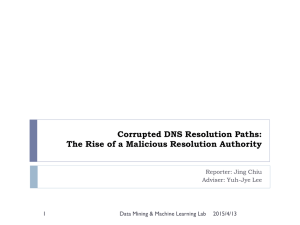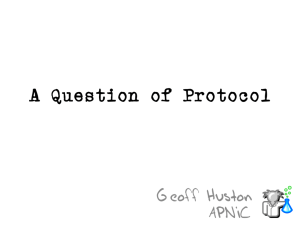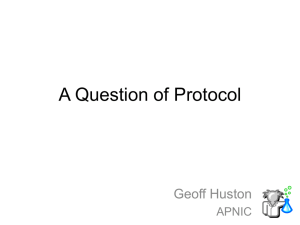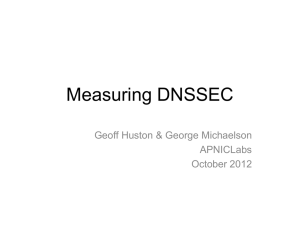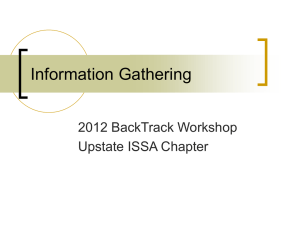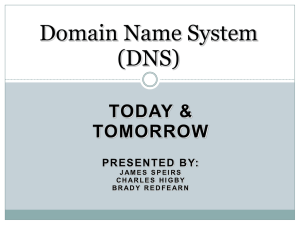+dnssec A - blabs.apnic.net
advertisement
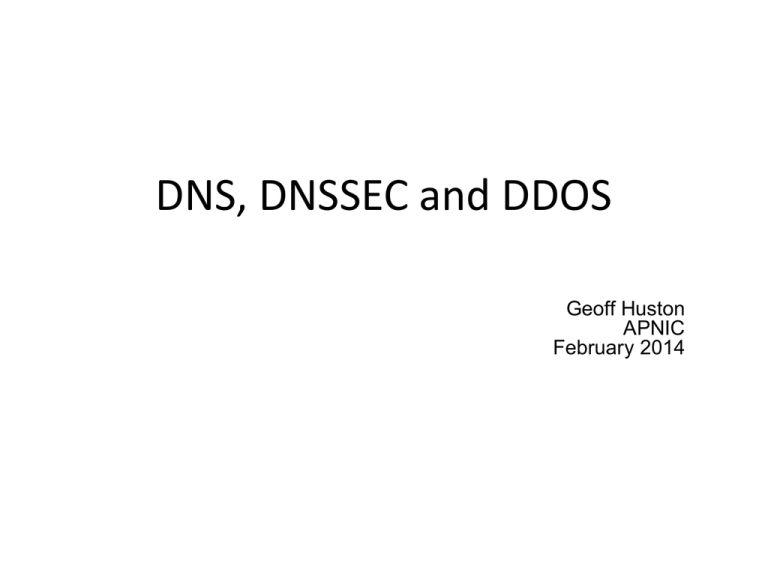
DNS, DNSSEC and DDOS Geoff Huston APNIC February 2014 The Evolution of Evil • It used to be that they sent evil packets to their chosen victim but this exposed the attacker, and limited the damage they could cause e.g. TCP SYN attack Attacker Victim The Evolution of Evil • Then they enrolled a bot army to send evil which kept the attacker hidden and increased the damage leverage Attacker Victim Massed URL retrieval Experiences what looks like a TCP syn attack! The Evolution of Evil • But now they co-opt the innocent to the evil cause, and use un-corrupted servers to launch the attack which hides the attacker(s) and uses the normal operation of servers to cause damage UDP is a Fine Protocol • • • • • UDP is used whenever you want a fast and highly efficient short transaction protocol Send a query to a server ( one packet) And the server sends an answer (one packet) UDP works best when the question and the answer are small (<512 bytes), but can work on larger transactions * Although it’s not as reliable as TCP fine print – you‘ll need to magnify this to read it! * The Some UDP applications use multiple UDP packets for large answers (e.g. NTP). Some rely of IP level fragmentation (e.g. DNS with EDNS0) The problem with relying on fragmentation is firewall filtering and NATs (the trailing frags have no transport level header to assist in locating the NAT binding , as fragme And the problem with multiple UDP packets is reliably reassembly is pushed into the application, which may not necessarily do this well! UDP Mutation • Unlike TCP there is no handshake between the two parties who are communicating • • • • Send the server a UDP packet The server flips the source and destination IP addresses and responds with a UDP packet The server never checks the authenticity of the source address This allows a simply reflection attack… UDP Reflection Attack Server Proto: UDP Dest: Server Source: Victim Proto: UDP Dest: Victim Source: Server Attacker Note the fake source! Victim UDP and DDOS Reflection Attacks This works “best” for a UDP-based service when • • • • • The service is widely used Servers are commonplace Servers are poorly maintained (or unmaintained) Clients are not “qualified” by the server (i.e. anyone can pose a query to a server) The answer is far bigger than the question Hmmmmm What could that be? DNS as an attack vector • UDP-based query response service UDP is now almost ubiquitous for the DNS – EDNS0 wiped out the last vestiges of TCP fallback • The service is widely used Everybody is a client of the DNS • Servers are commonplace Resolvers are scattered all over the Internet • Servers are poorly maintained (or unmaintained) There are some 30 million open resolvers • Clients are not “qualified” by the server (i.e. anyone can pose a query to a server) DNS servers are by design promiscuous Many DNS resolvers are unintentionally promiscuous • The answer is far bigger than the question Just ask the right DNS question! DNS and DDOS • • • • DNS DDOS attacks are now very commonplace on today’s Internet They can (and do) operate at sustained gigabit speeds They can use corrupted intermediaries to broaden the attack surface and further increase the query intensity And efforts to mitigate at the server tend to degrade the quality of the DNS service, as well as affecting the victim DNS Queries and Responses dig A isc.org - query size = 36 bytes 149.20.64.69 – response size = 52 bytes Conventional DNS queries and answers tend to be relatively poor attack amplifiers – in general the answer is not all that much larger than the question But there are particular questions that generate more impressive answers… The DNS ANY query dig ANY isc.org – query size = 36 bytes response size = 3,587 bytes That’s more like it! In this case the response is 100x larger than the query Blocking the ANY attack • Modify the resolver not to respond to ANY queries in a meaningful way $ dig ANY isc.org @8.8.8.8 ; <<>> DiG 9.8.3-P1 <<>> ANY isc.org @8.8.8.8 ;; global options: +cmd ;; Got answer: ;; ->>HEADER<<- opcode: QUERY, status: SERVFAIL, id: 6696 ;; flags: qr rd ra; QUERY: 1, ANSWER: 0, AUTHORITY: 0, ADDITIONAL: 0 ;; QUESTION SECTION: ;isc.org. IN ;; ;; ;; ;; ANY Query time: 632 msec SERVER: 8.8.8.8#53(8.8.8.8) WHEN: Sun Feb 16 09:42:48 2014 MSG SIZE rcvd: 25 The DNSSEC query With DNSSEC, if the client requests DNSSEC information, then the additional records in the response contain crypto values These crypto records can be quite large… dig +dnssec A isc.org – query = 36 bytes 149.20.64.69 – response = 1,619 bytes That’s an additional 1,567 bytes of crypto payload that has been provided by DNSSEC Blocking DNSSEC DNS attacks • Stop serving DNSSEC-signed zones • And/or configure resolvers to turn off the DNSSEC-OK EDNS0 flag But resolver-level query blocking defeats the entire purpose of DNSSEC! So we need to look to other measures to mitigate this vulnerability Possible responses Drop “excessive” queries at the resolver – collateral damage to the server and the served names – can lead to cache poisoning attacks Drop EDNS0 and revert to original DNS behaviour No DNS UDP responses over 512 bytes Requestor directed to use TCP instead – Poor DNS resolution performance for all clients – Can lead to server overload though increased TCP load Maybe we can combine the two approaches DNS Response Rate Limiting (RRL) • Set a maximum rate that any requestor will be told the same answer note: this is not about the query – its about the response! • Above this threshold either drop the query, or respond with the query and the truncated bit (TC) set ON – The ratio of candidate queries to TC responses is termed the “SLIP ratio” • Some folk say SLIP=2 is enough • Others seem to prefer SLIP=1 This will not eliminate the problem As the attacker can broaden the attack plane across a large set of open recursive resolvers and not overload any single resolver to trigger its local RRL response – And there are some ~30M such open resolvers http://openresolverproject.org But it does increase the effort required to mount an attack based on DNS reflection, due to the added need to distribute the attack profile over a large set of resolvers Attackers tend to exert no more effort than is strictly necessary to achieve the desired outcome, so increasing the effort needed to use the DNS to mount a reflection attack may well shift attention to other vulnerabilities, such as NTP What you need to be naughty What you need to be nice Add RRL to your DNS resolvers Clean up open DNS resolvers in your networks Limit queries on recursive resolvers to be sourced from your client cone, if you can But… • Being nice is not always possible – There is a significant volume of embedded DNS functionality in appliances and NAT-based consumerware – And enough of includes open DNS resolver functionality to be a problem that is not going to be “fixed” anytime soon It’s not just the DNS • NTP uses a UDP-based command and control channel over the same port as the time exchange (UDP port 123) • And NTP servers are often installed with an open config • The NTP monlist command is 220 bytes to send, and the response is a set of packets with a total volume of 46,800 bytes What you need to be nice Add RRL to your DNS resolvers Clean up open DNS resolvers in your networks Limit queries on recursive resolvers to come from your client cone, if you can While you are at it, do the same filtering for NTP, and the monlist command in particular In the longer term… • Commonly used protocols that can generate large UDP responses are a long term problem – And DNSSEC will not cram into a 512 byte payload in the DNS • So maybe it’s the ability to pass through IP packets through the network with a false IP source address that is the basic problem, and just UDP exposes this problem to application level behaviour What you need to be nice Add RRL to your DNS resolvers Clean up open DNS resolvers in your networks Limit queries on recursive resolvers to come from your client cone, if you can While you are at it do the same filtering for NTP, and the monlist command in particular Perform outbound traffic filtering to support source address validation: BCP38 Some Useful Resources Open DNS resolvers: http://openresolverproject.org DNS RRL description http://www.redbarn.org/dns/ratelimits Sealing up NTP – a template for ntp.conf http://www.team-cymru.org/ReadingRoom/Templates/secure-ntp-template.html Open NTP servers http://openntpproject.org BCP 38 http://bcp38.info BCP 38 tracking http://spoofer.cmand.org// Thanks!


